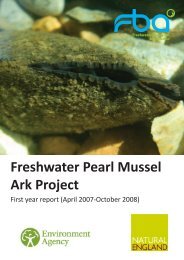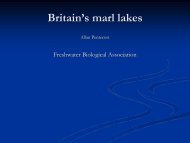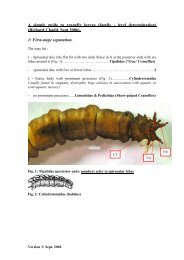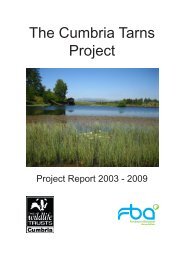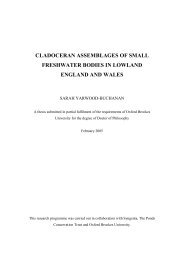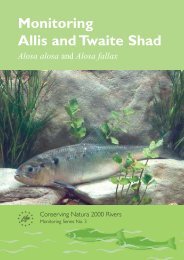Monitoring the Bullhead - European Commission
Monitoring the Bullhead - European Commission
Monitoring the Bullhead - European Commission
Create successful ePaper yourself
Turn your PDF publications into a flip-book with our unique Google optimized e-Paper software.
Executive summary<br />
Background<br />
The <strong>European</strong> Union (EU) Habitats Directive (92/43/EEC) on Conservation of Natural Habitats and of<br />
Wild Fauna and Flora stipulates that EU member states maintain or restore habitats and species in a<br />
condition that ensures <strong>the</strong>ir favourable conservation status in <strong>the</strong> community.To comply with this<br />
directive, a number of rivers have been designated as Special Areas of Conservation (SACs) because<br />
<strong>the</strong>y support important populations of vulnerable designated species.This report describes a<br />
standardised protocol to monitor bullhead stocks in SAC rivers to assess <strong>the</strong> conservation status of<br />
<strong>the</strong> species against a predetermined set of objectives.<br />
A review of <strong>the</strong> bullhead’s ecological and habitat needs (Tomlinson & Perrow 2003) concluded that <strong>the</strong><br />
key features that dictate <strong>the</strong>ir distribution and abundance are: water depth, water velocity and<br />
substratum composition.<br />
<strong>Bullhead</strong> condition assessment<br />
Two strategies are proposed for assessment of favourable conservation status of bullhead populations<br />
in SAC rivers: abundance classification and population demographic structure.<br />
Abundance classification<br />
The first approach classifies <strong>the</strong> density of bullheads in order to establish <strong>the</strong> relative condition of fish<br />
populations in rivers.The target for favourable conservation status in upland streams is set at a<br />
conservative 0.2 individuals m -2. Compliance in lowland rivers is set at an average adult relative<br />
population density above 0.5 individuals m -2. Abundances less than <strong>the</strong>se targets indicate<br />
rivers/reaches/sites in unfavourable condition. It is important that an appropriate number of sites are<br />
surveyed to account for natural spatial variation in bullhead population size in <strong>the</strong> SAC river under<br />
examination.<br />
Population demographic structure<br />
A fur<strong>the</strong>r assessment can be made of <strong>the</strong> demographic structure of <strong>the</strong> population (<strong>the</strong> contribution of<br />
juveniles to <strong>the</strong> population to demonstrate recruitment success).To achieve favourable conservation<br />
status, where bullhead populations are abundant in discrete sections of a river, more than 40% of <strong>the</strong><br />
individuals should be in <strong>the</strong> 0+ age class.<br />
Deviation from compliance should not occur in more than one year in two, since populations have<br />
short life spans. However, care must be taken when interpreting <strong>the</strong> output because of natural<br />
variability in river systems, and where possible <strong>the</strong> assessments should be made on individual rivers or<br />
sections of rivers where discrete populations are known to exist.<br />
Fur<strong>the</strong>r assessment of <strong>the</strong> status can be derived from mapping <strong>the</strong> distribution of bullheads in individual<br />
SAC rivers. Favourable conservation status should be recorded if <strong>the</strong>re is no decline in distribution<br />
from <strong>the</strong> current, or where available, historical pattern.<br />
<strong>Monitoring</strong> strategy<br />
<strong>Monitoring</strong> <strong>the</strong> <strong>Bullhead</strong><br />
<strong>Monitoring</strong> by electric fishing is recommended to provide an overview of <strong>the</strong> status of bullhead<br />
populations in SAC river catchments. A combination of quantitative (multi-run depletion method) and<br />
semi-quantitative (calibration method) sampling is recommended. Prior to undertaking fisheries surveys<br />
<strong>the</strong>re is a need to ensure <strong>the</strong> appropriate access and fishing rights have been cleared. Electric fishing<br />
5




